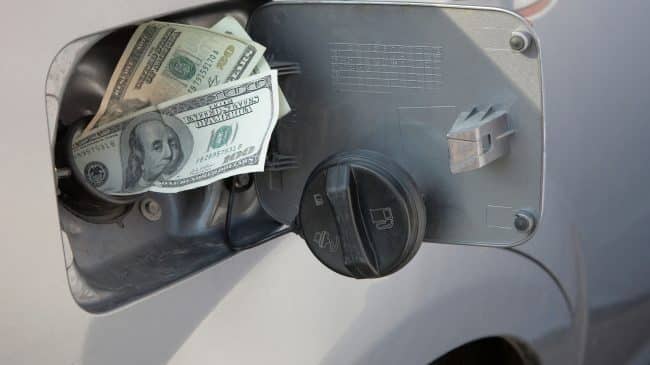The gas tax is supposed to be based on the users-pay/users-benefit principle. When it was created, the vision was that drivers would pay the gas tax, which would be used to maintain the highways drivers were using and paying gas taxes for. Unfortunately, times have changed. Today, 31 states divert a portion of their gas tax revenue to non-road-related expenditures, with five diverting over one-third of their total fuel tax revenue to non-road uses and an additional five states diverting at least one-quarter of their fuel taxes to non-road projects.
These diversions weaken the users-pay argument for the gas tax and end up harming the quality of our roads.
Oregon passed the first motor fuel tax in February 1919 to fund road construction. Early revenue was allocated to build the Pacific Highway and the Columbia River Highway. Within the following decade, all states and the District of Columbia had their own motor fuel taxes.
Today, gas taxes are levied by every state, ranging from 14.32 cents per gallon in Alaska to 62.05 cents per gallon in California.
While the proliferation of electric cars and increased fuel-efficiency of conventional engines threaten the long-term viability of fuel taxes to fund road maintenance sufficiently in the long-term future, the diversion of gas tax revenue toward non-road projects plays a significant role in the current condition of roads and highways and is important in assessing the gas tax’s long-term viability as a way to build and maintain roads.
Northeastern states have some of the largest percentages of fuel tax diversions. Connecticut is the state that diverts the largest portion of its motor fuel tax—57.8 percent. While Connecticut’s fuel tax generated over $506 million in 2018, 40 percent of it funded general state debt and a large portion went to subsidize mass transportation. Meanwhile, perhaps not surprisingly, Connecticut’s highways ranked 44th in overall performance and cost-effectiveness in the most recent Annual Highway Report.
Connecticut’s northeast neighbors are the states with the second, third and fourth highest diversion rates: New York, Rhode Island and New Jersey, respectively. New York diverts 37.4 percent of all fuel tax revenue toward mass transit. Also troublingly, of its non-diverted gas tax revenue, New York allocates $379 million to pay down the New York Department of Transportation’s (NYDOT) debt. In fact, only 13.8 percent of New York’s gas tax revenue is specifically dedicated to current highway and road capital projects, while another 25.4 percent is allocated for NYDOT operations—a category which includes the cost of road maintenance, from salaries to equipment costs, but also additional administrative diversions.
Rhode Island allocates 27.9 percent of its motor fuel tax revenue to mass transit and an additional 2.9 percent to the Department of Human Services (DHS) to cover the transportation costs of veterans and disabled individuals, among others. Those transferred funds, however, are simply deposited into DHS’s operating budget, leaving little accountability over the allocation of how the money is actually spent.
New Jersey’s overall diversion rate of 34 percent is composed of a $676 million allocation of gas tax revenue to NJ Transit, New Jersey’s public transportation corporation, and a $2 million allocation to fund various sidewalk and pedestrian projects it says are meant to transform certain municipalities into transit-oriented villages.
Many other states also divert revenue toward public transportation, with prime examples being Maryland and Massachusetts, which divert 27.8 percent and 23.7 percent of their gax tax revenue to mass transit respectively. Smaller diversions toward public transportation include Michigan at 1.6 percent, Tennessee at 3.3 percent and Vermont at 2.6 percent. Colorado authorizes its municipalities to use 15 percent of their fuel tax revenue share on transit, which accounts for about 5 percent of overall gas tax revenue in that state.
States also frequently use gas tax money to fund state-level executive departments. Michigan diverts 25.9 percent and Texas diverts 24.7 percent of gas tax revenue to school aid funds. Similarly, Georgia diverts 13.1 percent of gas tax revenue to K-12 and secondary education. Kentucky distributed a quarter of its motor fuel tax revenue to help balance the budgets of any executive department running a deficit. Colorado, Maine, Pennsylvania and Vermont all use a portion of their gas tax revenue to fund state police operations.
Small line-item diversions can add-up as well. Washington state, for example, diverts $3.9 million to vanpool services, $11.1 million to bike and pedestrian programs, $9.4 million to bike and pedestrian safety, $4 million to two separate sidewalk programs, and a whopping $37.5 million toward fish barrier removal efforts. Combined with other diversions toward rail and buses, Washington’s overall diversion rate is 10.2 percent of its gas tax revenue.
Other increasingly common diversions are things like North Carolina’s 3 percent diversion toward municipal sidewalks and bike programs and Vermont’s 1.2 percent diversion for visitor center construction and maintenance.
And then there’s North Dakota, which diverted $4.7 million, just under one percent of its fuel tax revenue, to its Ethanol Subsidy Fund. Thus, North Dakota effectively subsidizing a component of the very fuel that it’s taxing.
While the long-term future of gas taxes is likely limited, with a shift toward mileage-based user fees making the most sense, states need to prioritize road and bridge maintenance. Some of the state governments claiming they do not have the funding to make much-needed improvements to their roads and highways would have they weren’t diverting gas tax money to non-road uses.
Gas taxes aren’t supposed to be a slush-fund for states. Drivers pay gas taxes and transportation departments and politicians should ensure those taxes go toward maintaining and improving roads and bridges.


